RTX A S 4100 Small form-factor 802.11 b/g/n Wi-Fi module with on-board low power application processor User Manual
RTX A/S Small form-factor 802.11 b/g/n Wi-Fi module with on-board low power application processor Users Manual
RTX A S >
Users Manual
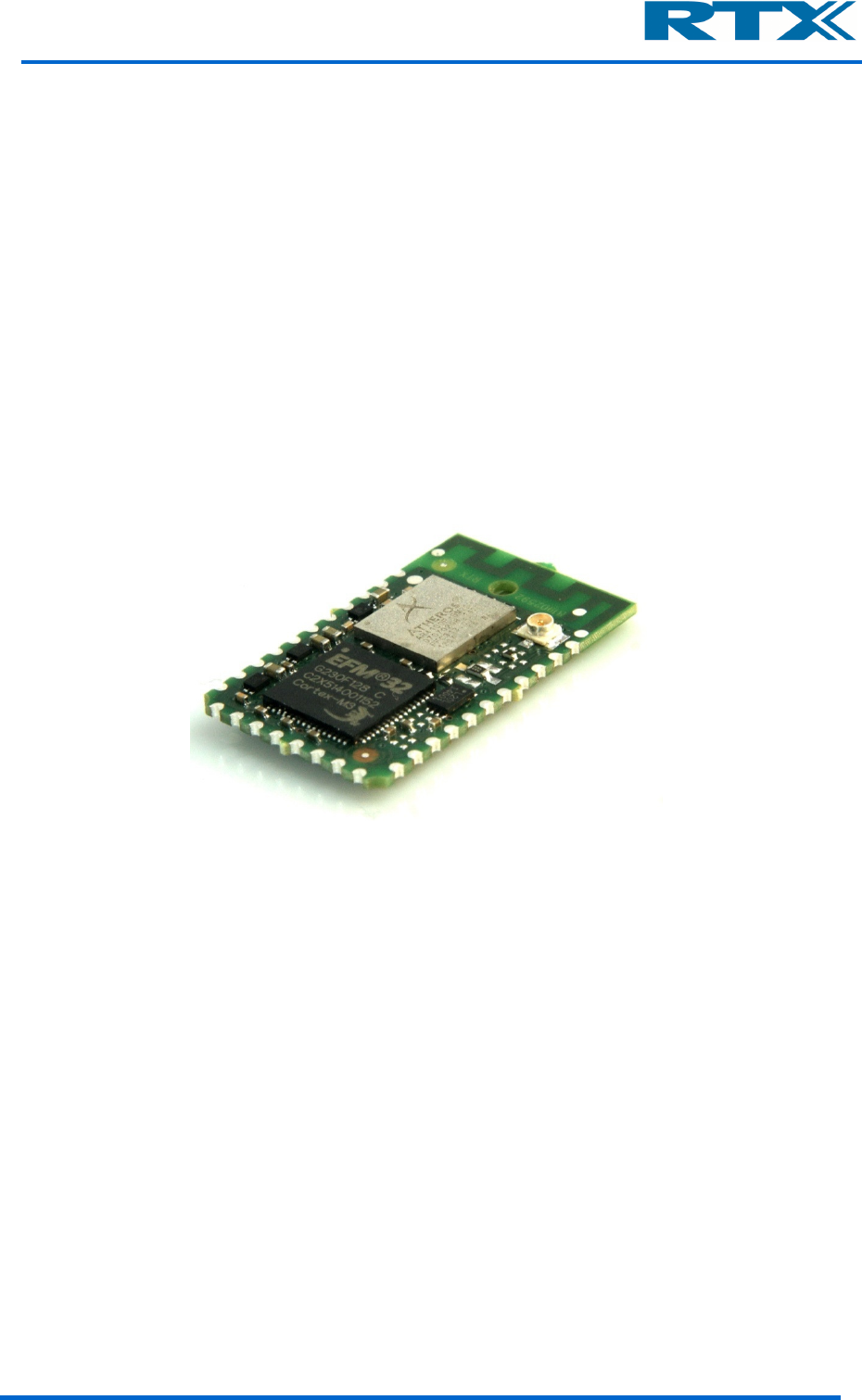
Application note – Regulatory Approvals RTX4100 – Wi-Fi Module 1
RTX4100
Wi-Fi Module
Application note
Regulatory Approvals
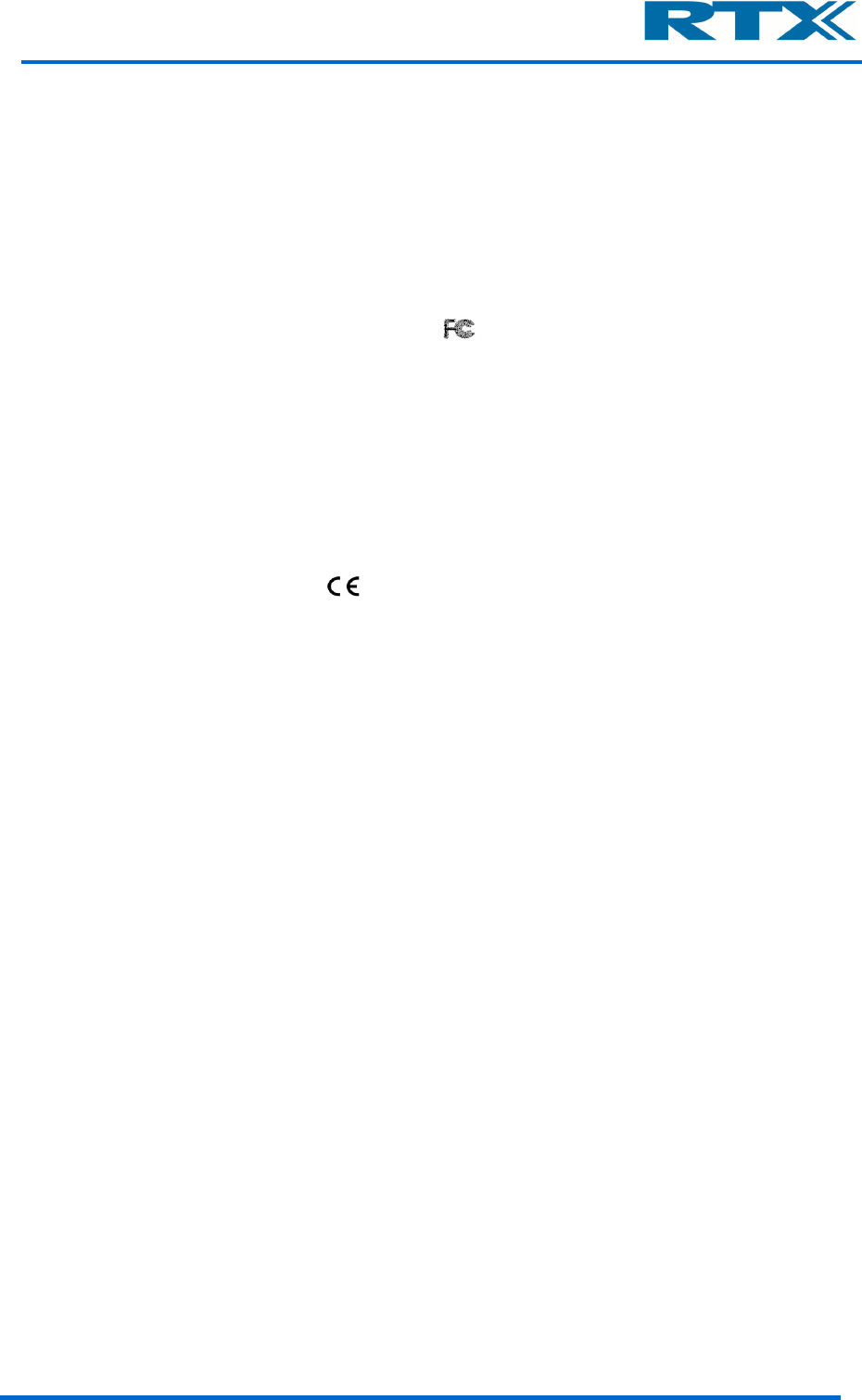
Application note – Regulatory Approvals RTX4100 – Wi-Fi Module 2
CONTENT
1
Introduction ............................................................................................................................................ 3
1.1
General Description .................................................................................................................................. 3
1.2
Document History ..................................................................................................................................... 3
1.3
Document References .............................................................................................................................. 3
2
Regulated Approvals ............................................................................................................................... 4
2.1
USA (Federal Communications Commission, FCC, ) ........................................................................... 4
2.1.1
FCC Labeling Requirements ........................................................................................................... 5
2.1.2
End User Manual ........................................................................................................................... 5
2.1.3
RF Exposure ................................................................................................................................... 6
2.2
Canada (Industry Canada, IC) .................................................................................................................... 7
2.2.1
IC labeling requirements ............................................................................................................... 7
2.3
Canada (Industrie Canada, IC)................................................................................................................... 8
2.3.1
Exigences d’étiquetage IC ............................................................................................................. 8
2.4
Europe (Conformité Européenne, ) .................................................................................................... 9
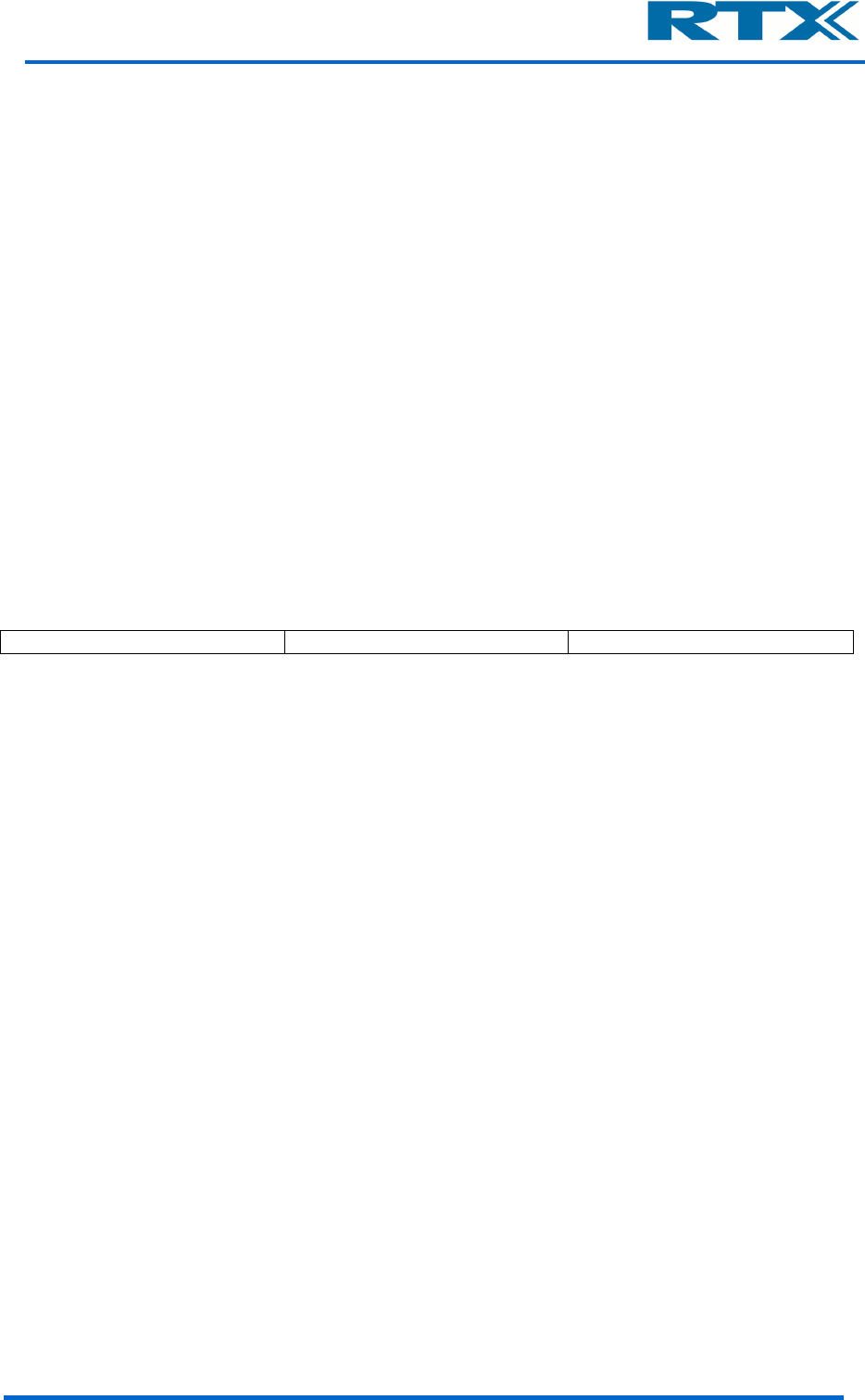
Application note – Regulatory Approvals RTX4100 – Wi-Fi Module 3
1 Introduction
1.1 General Description
The RTX4100 Wi-Fi Module is a small form-factor, single stream, 802.11b/g/n Wi-Fi mo-
dule with on-board low power application processor. It is targeted at applications that
send infrequent data packets over the network. Typically, these 802.11 applications will
place a higher priority on system cost, power consumption, ease of use, and fast wake-
up times as compared to high throughput.
The RTX4100 has received regulatory approvals for modular devices in the United States
(FCC) and Canada (IC), and regulatory approvals in Europe (ETSI). The modular
approval allows the integrator to place the RTX4100 using either the internal antenna or
an approved antenna inside a finished product without having to perform costly
regulatory testing. The requirements the integrator must fulfil to use modules without
additional testing are listed in this Application Note.
1.2 Document History
V1.0 Official release PEW 2012-08-28
Disclaimer: This document can be subject to change without prior notice.
1.3 Document References
There are no sources in the current document.
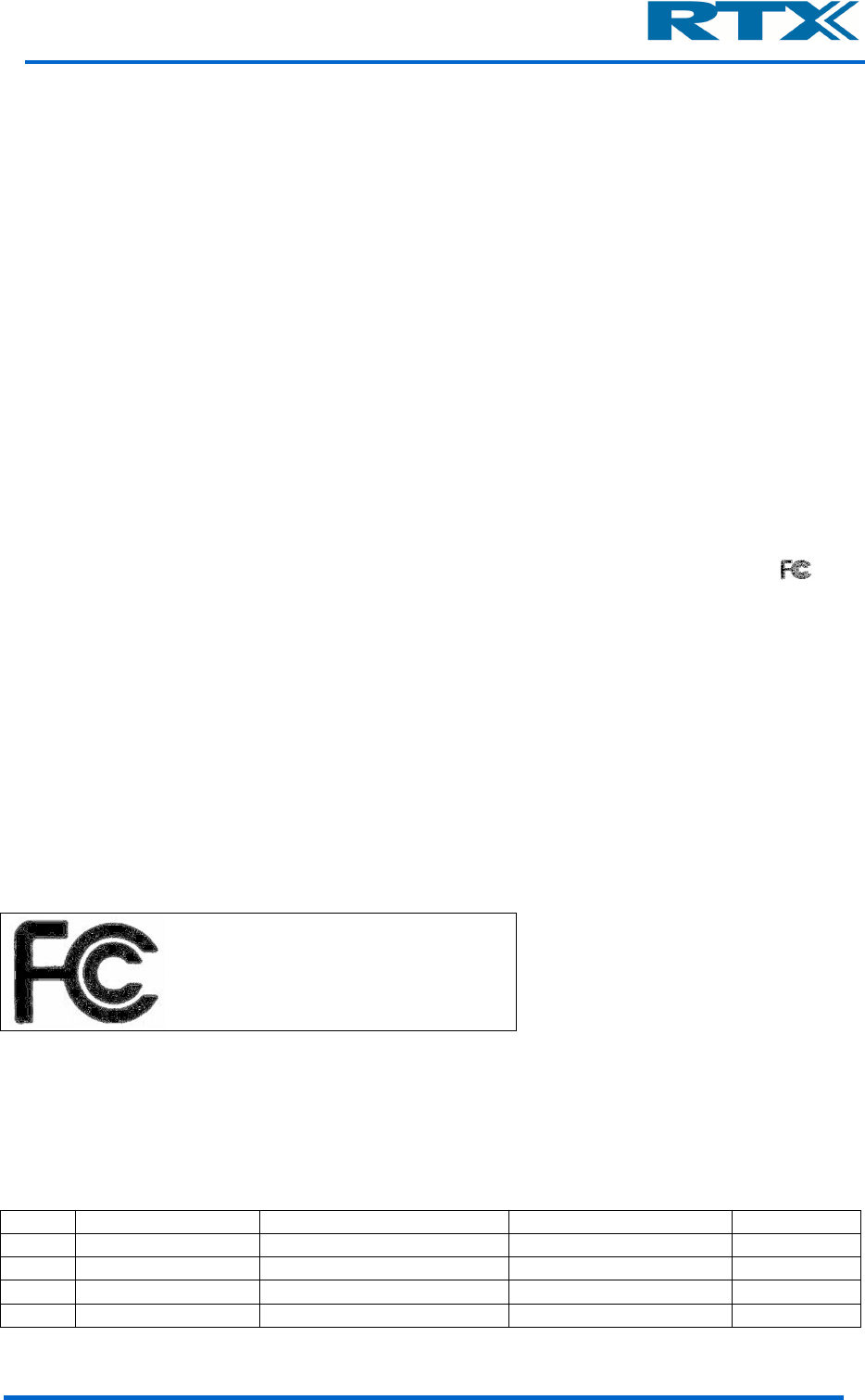
Application note – Regulatory Approvals RTX4100 – Wi-Fi Module 4
2 Regulated Approvals
The RTX4100 has been designed to meet most national regulations for world-wide ISM-
band use. In particular the radio modules have been certified to the following standards
.
• FCC Part 15.247
• IC
o RSS Gen (CNR-Gen), Issue 3
o RSS-210 (CNR-210), Issue 8
• ETSI
o EN 300 328 (V1.7.1)
o EN 301 489-01 (V1.8.1)
o EN 301 489-17 (V2.1.1)
2.1 USA (Federal Communications Commission, FCC, )
The RTX4100, with integrated antenna, as well as used with the antennae listed in Table
1 below, have been tested to comply with FCC CFR47 Part 15 sub-part C “Intentional
Radiators”. The devices meet the requirements for modular transmitter approval as
detailed in FCC Part 15 Section 15.212 Modular Transmitters. The RTX4100 module can
be integrated into a finished product without obtaining subsequent FCC approvals.
The RTX4100 modules complies with part 15 of the FCC rules. Operation is subject to the
following two conditions: (1) this device may not cause harmful interference, and (2) this
device must accept any interference received, including interference that may cause
undesired operation
.
Changes or modifications to the equipment not expressly approved by the party
responsible for compliance could void the user's authority to operate the equipment.
RTX A/S
FCC ID: S9J4100
According to FCC Part 15 section 15.204(a4) Any antenna that is of the same type and of
equal or less directional gain as an antenna that is authorized with the intentional
radiator may be marketed with, and used with, that intentional radiator. No retesting of
this system configuration is required.
Table 1 Approved Antennas
Item Part Number Manufacturer Type Gain (dBi)
1 Internal antenna RTX Internal PCB antenna 1.9
2 GW17.07.0250E Taoglas Dipole 2.7
3 PC17.07.0070A Taoglas External PCB antenna
0.9
4 2118059-1 TE Connectivity Single Band Antenna 4.0
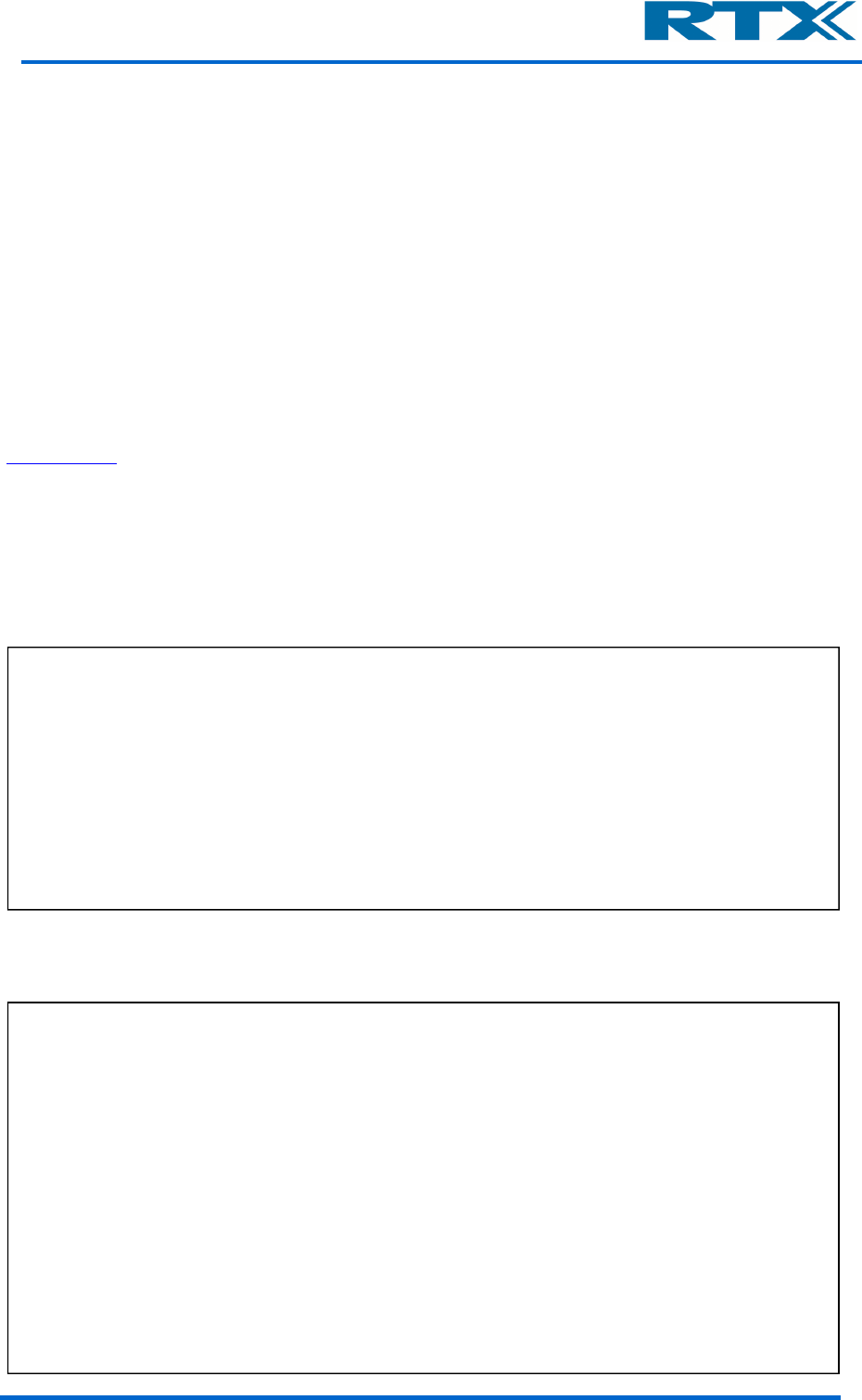
Application note – Regulatory Approvals RTX4100 – Wi-Fi Module 5
When integrating the RTX4100 into a finished product with mains supply additional
approval is required according to FCC Part 15 section 15.207(a). The RTX4100 does
comply to the FCC Part 15 section 15.207(c) for battery powered omitting FCC Part 15
section 15.207(a).
FCC Part 15 Section 15.207(a) states: “Except as shown in paragraphs (b) and (c) of this
section, for an intentional radiator that is designed to be connected to the public utility
(AC) power line, the radio frequency voltage that is conducted back onto the AC power
line on any frequency or frequencies, within the band 150 kHz to 30 MHz, shall not
exceed the limits in the following table, as measured using a 50 µH/50 ohms line
impedance stabilization network (LISN). Compliance with the provisions of this paragraph
shall be based on the measurement of the radio frequency voltage between each power
line and ground at the power terminal. The lower limit applies at the boundary between
the frequency ranges.” Table and other paragraphs refered to in quote can be found in
FCC Part 15.
2.1.1 FCC Labeling Requirements
The RTX4100 module has been labeled with its own FCC ID number and if the FCC ID is
not visible when the module is installed inside another device, then the outside of the
finished product into which the module is installed must also display a label referring to
the enclosed module. This exterior label can use wording such as the following:
2.1.2 End User Manual
The end user manual should include the following statement:
Contains Transmitter Module FCC ID: S9J4100
-or-
Contains FCC ID: S9J4100
This device complies with the Part 15 of the FCC Rules.
(1) this device may not cause harmful interference, and (2) this device must accept
any
interference received, including interference that may cause undesired operation.
This equipment has been tested and found to comply with the limits for a Class B
digital device, pursuant to part 15 of the FCC Rules. These limits are designed to
provide reasonable protection against harmful interference in a residential
installation. This equipment generates, uses and can radiate radio frequency energy
and, if not installed and used in accordance with the instructions, may cause harmful
interference to radio communications. However, there is no guarantee that
interference will not occur in a particular installation. If this equipment does cause
harmful interference to radio or television reception, which can be determined by
turning the equipment off and on, the user is encouraged to try to correct the
interference by one or more of the following measures:
•Reorient or relocate the receiving antenna.
•Increase the separation between the equipment and receiver.
•Connect the equipment into an outlet on a circuit different from that to which
the receiver is connected.
•
Consult the dealer or an experienced radio/TV technician for help.
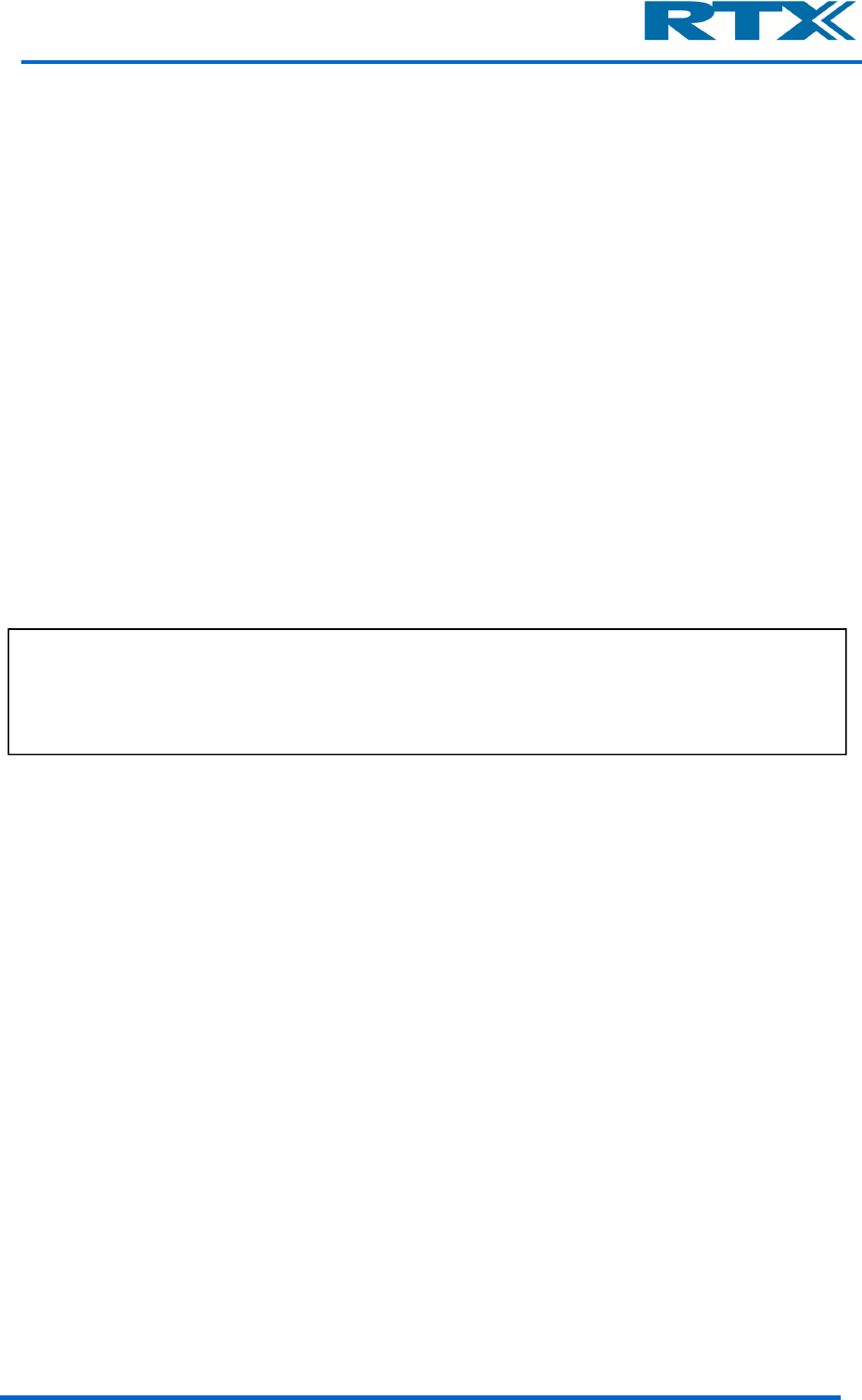
Application note – Regulatory Approvals RTX4100 – Wi-Fi Module 6
2.1.3 RF Exposure
This device complies with FCC RF radiation exposure limits set forth for an
uncontrolled environment. The antenna used for this transmitter must be installed
to provide a separation distance of at least 20 cm from all persons and must not be
co-located or operating in conjunction with any other antenna or transmitter.
All transmitters regulated by the FCC must comply with RF exposure requirements. OET
Bulletin 65 “Evaluating Compliance with FCC Guidelines for Human Exposure to Radio
Frequency Electromagnetic Fields” provides assistance in determining whether proposed
or existing transmitting facilities, operations or devices comply with limits for human
exposure to Radio Frequency (RF) fields adopted by the Federal Communications
Commission (FCC). The bulletin offers guidelines and suggestions for evaluating
compliance.
If appropriate, compliance with exposure guidelines for mobile and unlicensed devices
can be accomplished by the use of warning labels and by providing end users with
information concerning minimum separation distances from transmitting structures and
proper installation of antennas.
The following statement must be included as a CAUTION statement in manuals and OEM
products to alert end users of FCC RF Exposure compliance:
If the RTX4100 module is used in a portable application (antenna is less than 20 cm from
persons during operation), the end user is responsible for performing Specific Absorption
Rate (SAR) testing in accordance with FCC rules 2.1091.
To satisfy FCC RF Exposure requirements for mobile and base station transmission devices, a
separation distance of 20 cm or more should be maintained between the antenna of this device
and persons during operation. To ensure compliance, operation at closer than this distance is not
recommended. The antenna(s) used for this transmitter must not be co-located or operating in
conjunction with any other antenna or transmitter.
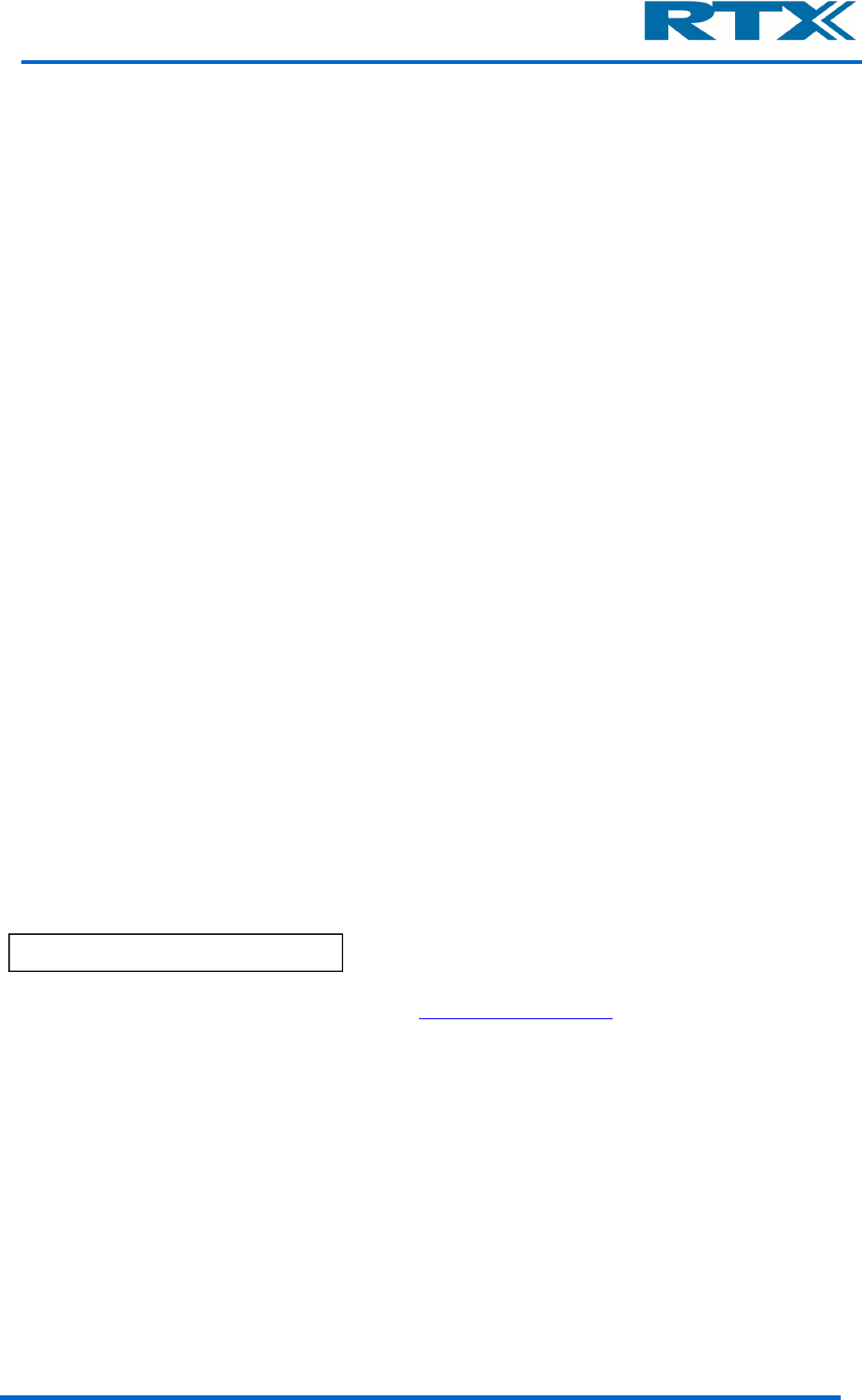
Application note – Regulatory Approvals RTX4100 – Wi-Fi Module 7
2.2 Canada (Industry Canada, IC)
The RTX4100 module has been certified for use in Canada under Industry Canada (IC)
Radio Standards Specification (RSS) RSS-210 and RSS-Gen.
This Class B digital apparatus complies with Canadian ICES-003.
This device complies with Industry Canada licence-exempt RSS standard(s). Operation is
subject to the following two conditions: (1) this device may not cause interference, and
(2) this device must accept any interference, including interference that may cause
undesired operation of the device.
From section 3.2 RSS-Gen, Issue 3, December 2010, Modular Approval for Category I
Equipment or Category II Equipment:
Modular approval permits the installation of the same module in a host device or multiple
host devices without the need to recertify the device. Equipment certification for a
modular device may be sought for either Category I equipment or Category II
equipment.
Transmitters designed as modules for the installation in a host device may obtain
equipment certification as a modular device provided that the applicable RSS is met and
the following conditions in this section are met.
2.2.1 IC labeling requirements
The host device shall be properly labeled to identify the modules within the host device.
The Industry Canada certification label of a module shall be clearly visible at all times
when installed in the host device, otherwise the host device must be labeled to display
the Industry Canada certification number of the module, preceded by the words
“Contains transmitter module”, or the word “Contains”, or similar wording expressing the
same meaning, as follows:
Label:
For more information see: Industry Canada http://www.ic.gc.ca/
Contains IC: 4979A
-
4100
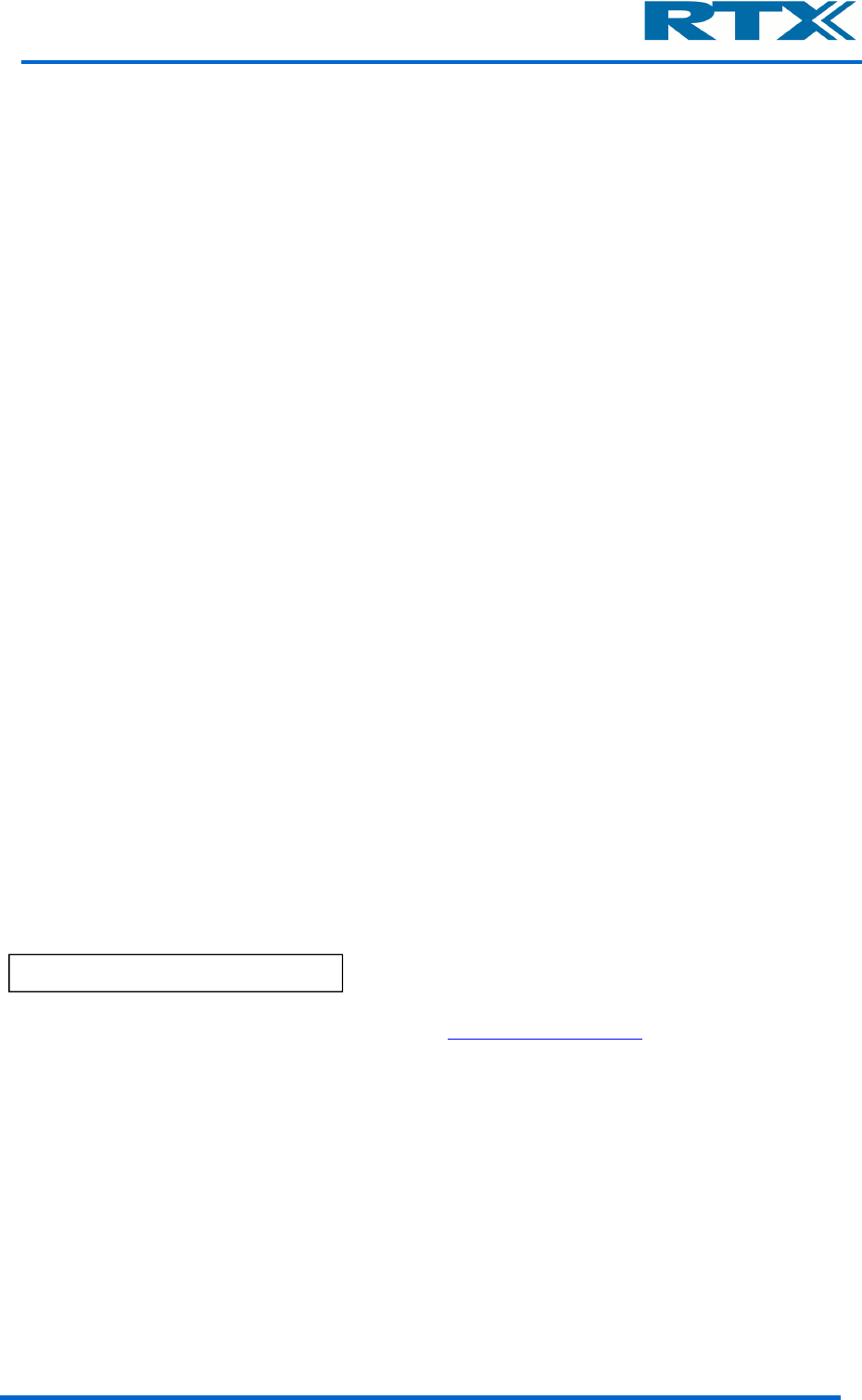
Application note – Regulatory Approvals RTX4100 – Wi-Fi Module 8
2.3 Canada (Industrie Canada, IC)
Le module RTX4100 a été certifié pour un usage au Canada avec les Cahier des charges
sur les normes radioélectriques (CNR) pour l’Industrie Canada (IC) CNR-210 et CNR-Gen.
Cet appareil numérique de la classe B est conforme à la norme NMB-003 du Canada.
Le présent appareil est conforme aux CNR d’Industrie Canada applicables aux appareils
radio exempts de licence. L’exploitation est autorisée aux deux conditions suivantes: (1)
l’appareil ne doit pas produire de brouillage, et (2) l’utilasteur de l’appereil doit accepter
tout brouillage radioélectrique subi, même si le brouillage est susceptible d’en
compromettre le fonctionnement.
Tiré de la section 3.2 CNR-Gen, 3
ème
edition, de Décembre 2010, l’approbation modulaire
de matériel de catégorie I ou de matériel de catégorie II:
L’approbation modulaire permet l’installation du même module dans un ou plusieurs
appareils hôtes sans qu’il soit nécessaire d’obtenir une nouvelle certification de l’appareil.
La certification de matériel à l’egard d’un appareil modulaire peut être demandée dans le
cas du matériel du catégorie I ou du matériel du catégorie II.
Les émetteurs conçus comme modules en vue de leur installation dans un appareil hôte
peuvent obtenir une certification de matériel comme dispotifs modulaires, pourvu que le
CNR applicable soit respecté et que les conditions de la présente section qui suivent
soient respectées.
2.3.1 Exigences d’étiquetage IC
L'appareil hôte doit être étiqueté comme il faut pour permettre l’identification des
modules qui s’y trouvent.
L’étiquette de certification d’Industrie Canada d’un module donné doit être posée sur
l’appereil hôte à un endoit bien en vue en tout temps. En l’absence d’étiquette, l’appareil
hôte doit porter une étiquette donnant le numéro de certification du module d’Industrie
Canada, précédé des mots «Contient un module d’émission», du mot «Contient» ou
d’une formulation similaire exprimant le même sens, comme suit:
Label:
Pour plus d’information, voir: Industry Canada http://www.ic.gc.ca/
Contient IC: 4979A-4100
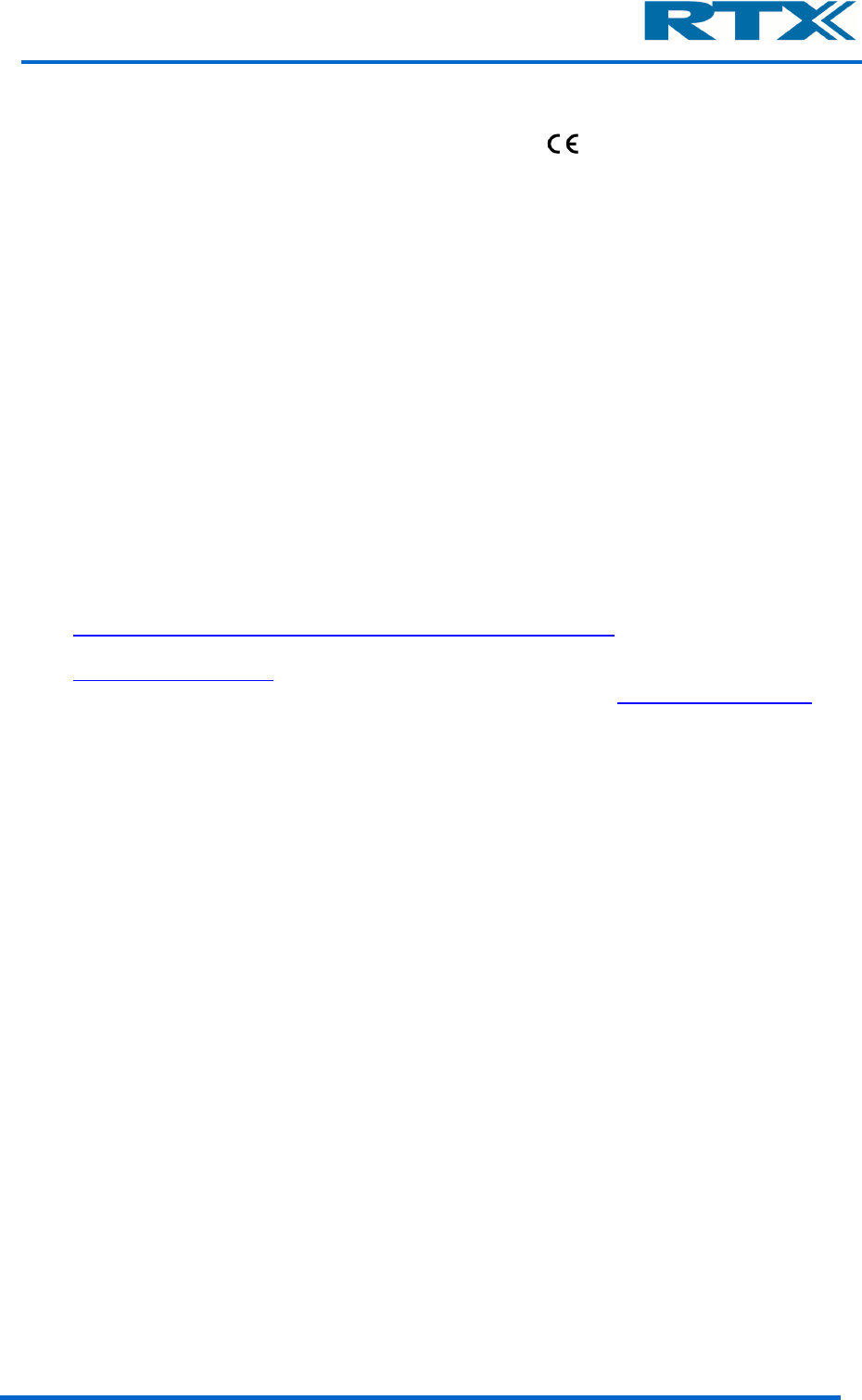
Application note – Regulatory Approvals RTX4100 – Wi-Fi Module 9
2.4 Europe (Conformité Européenne, )
The RTX4100 module has been certified for use in European countries. The following
testing has been completed:
Test standard ETSI EN 300 328 V1.7.1 (2006-10)
• Maximum Transmit Power
• Maximum EIRP Spectral Density
• Frequency Range
• Radiated Emissions
Test standards ETSI EN 301 489-1 V1.8.1 and ETSI EN 301 489-17 V2.1.1
• Radiated Emissions
• Radiated RF Susceptibility
The end user is responsible for ensuring compliance with harmonized frequencies and
labeling requirements for each country the end device is marketed and sold.
For more information see:
• Radio And Telecommunications Terminal Equipment (R&TTE)
http://ec.europa.eu/enterprise/sectors/rtte/index_en.htm
• European Conference of Postal and Telecommunications Administrations (CEPT)
http://www.cept.org/
• European Telecommunications Standards Institute (ETSI) http://www.etsi.org/